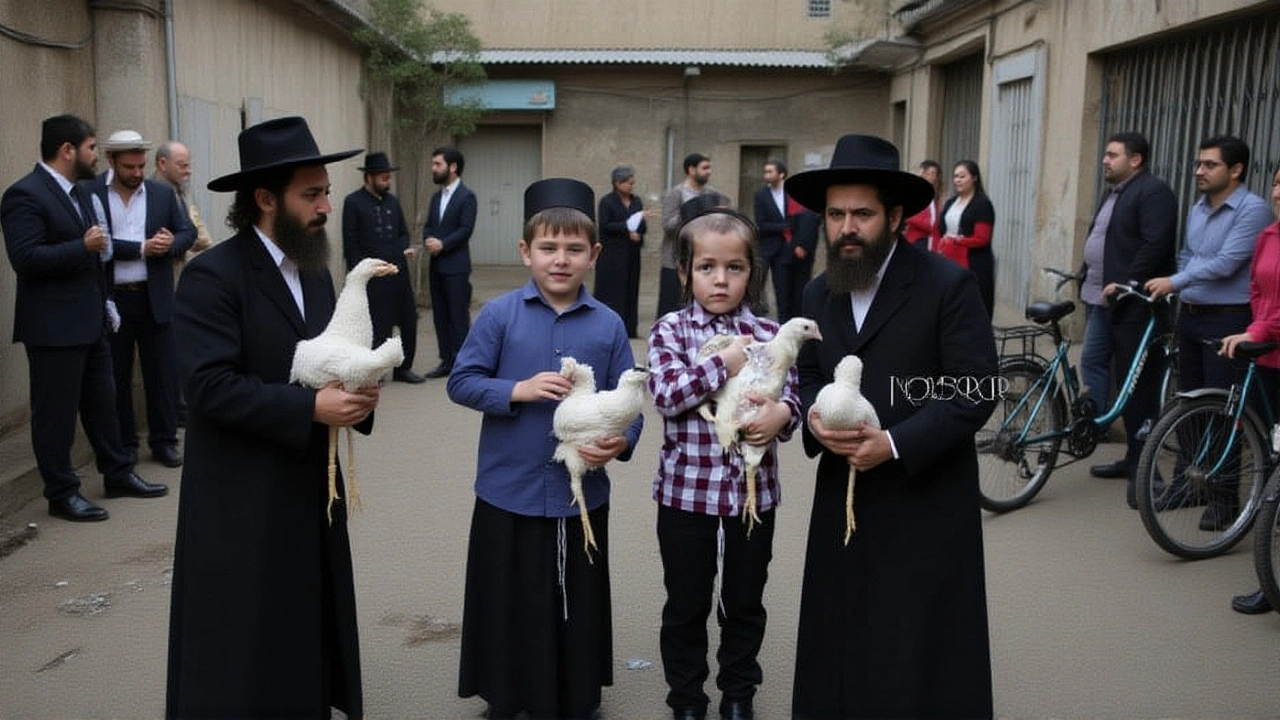Ultra‑Orthodox Jews Hold Kaparot Ritual in Bnei Brak as Yom Kippur Approaches

On September 20, 2023, Bnei Brak, a densely populated suburb of Tel Aviv, became the unlikely stage for a centuries‑old rite that still sparks fierce debate within the Jewish world. Ultra‑Orthodox congregants gathered in streets and community halls to perform the Kaparot ceremony – a symbolic act of atonement that involves swinging live white chickens over one’s head while reciting verses from Psalms, all in preparation for Yom Kippur, the holiest day on the Jewish calendar.
The same ritual unfolded later that day in Beit Shemesh, another city with a sizable Haredi population. Photographers from Xinhua News Agency captured participants clutching the birds, chanting, and handing the slaughtered chickens over to local charities. The event, officially listed as the Kapaarot ceremony, drew dozens of families, each hoping the ritual would serve as a "substitute" for their sins during the Ten Days of Repentance that sit between Rosh Hashanah and Yom Kippur.
Historical roots of the Kaparot tradition
The practice dates back to the early Middle Ages, when Jewish communities in the Middle East and Europe adopted a ritual that mirrored ancient Near‑Eastern customs of offering a sacrificial animal in place of a person. The Hebrew word "kaparot" literally means "exchanges" or "atonements," echoing the idea of transferring personal transgressions onto another entity – in this case, a chicken for males or a hen for females.
According to rabbinic sources, the ritual is performed during the pre‑dawn hours on the day before Yom Kippur, when a "thread of divine kindness" is believed to be especially potent. Participants swing the bird three times over their heads while reciting verses such as Psalms 107:10 – "Some lived in deepest darkness, bound in cruel irons" – and Psalms 107:14 – "He brought them out of deepest darkness, broke their bonds asunder." The bird is then declared a substitute, and after being slaughtered by a qualified shochet, it is donated to charitable organizations.
The 2023 ceremony in Bnei Brak and Beit Shemesh
The Bnei Brak event began just after sunrise, with a line of volunteers setting up tables, cages of white chickens, and a makeshift stage for the rabbi who would lead the prayers. Families arrived with their own birds, while others purchased chickens on the spot from a local vendor who had secured a kosher slaughterer for the day.
After the chanting, each participant gently passed the bird over their head, a motion meant to symbolically transfer impurity. The shochet then performed the shechita, the ritual slaughter required by Jewish law, ensuring the process adhered to the highest standards of kashrut. Once the chickens were deemed fit, they were handed over to volunteers from various Israeli charities, who promised to distribute the meat to needy families during the holiday week.
In Beit Shemesh, the atmosphere was similar but on a slightly larger scale. The municipal hall hosted a series of Kaparot stations, each manned by a different community leader. A poignant moment came when a pregnant woman stepped forward, holding three chickens – two hens for herself and a rooster for the unborn child, reflecting a long‑standing tradition that acknowledges the unknown gender of the baby.
Rabbinic opposition and the controversy surrounding Kaparot
Despite its deep roots, the ritual has never been universally accepted. Since the 19th century, many leading rabbis have condemned Kaparot as a vestige of superstition, likening it to the pagan‑like Tashlikh ceremony performed on Rosh Hashanah, where sins are symbolically cast into a body of water.
Critics argue that the practice borders on idolatry, turning a spiritual exercise into a literal animal sacrifice. Others point to animal‑rights concerns, noting that modern poultry farms rarely provide the humane conditions implied by the ritual’s ancient origins. In recent decades, several Israeli municipalities have banned live‑bird Kaparot, offering a monetary substitute instead.Nevertheless, ultra‑Orthodox leaders maintain that the ceremony is a vital conduit for personal reflection. "When we swing the chicken, we are reminded of the fragility of life and the need for repentance," said a senior rabbi at the Bnei Brak ceremony, speaking on condition of anonymity. He added that the charitable aspect – feeding families who might otherwise go hungry during the High Holy Days – is an essential component that offsets any discomfort.
Charitable dimension and modern adaptations
After the birds are slaughtered, they do not simply disappear. Charities such as "Nefesh HaMeuhad" and local soup kitchens receive the meat, which they then prepare for distribution to impoverished families throughout the Yom Kippur period. In Bnei Brak, volunteers reported that the donations would sustain roughly 150 households.
For those who cannot afford live chickens, the ritual can be performed through a charitable donation. The amount traditionally equivalent to the cost of a bird – roughly 30 shekels (about $9) – is given to a designated fund, and the donor recites the same verses while visualizing the act.
In recent years, some synagogues have begun offering a "cash‑instead" option, acknowledging both the financial burden on lower‑income families and the growing ethical concerns about animal welfare. This adaptation has been endorsed by several prominent rabbis, who argue that the essence of Kaparot lies in the intention, not the physical bird.
Looking ahead: The future of Kaparot in Israel
As Israel continues to grapple with the balance between tradition and modern sensibilities, the Kaparot ceremony stands at a crossroads. Younger members of the ultra‑Orthodox community, who are increasingly exposed to global animal‑rights campaigns, are beginning to question the practice's relevance.
Yet, for many, the ritual remains a cornerstone of personal atonement. The upcoming Yom Kippur season will likely see a mix of live‑bird ceremonies, charitable donations, and perhaps new forms of symbolic substitution yet to emerge.
Whatever the path, the core idea – seeking forgiveness and renewal before the holiest day of the Jewish year – endures. As the shofar sounds on the eve of Yom Kippur, the echo of the chicken‑swinging chants will linger in the streets of Bnei Brak, Beit Shemesh, and beyond, reminding believers that tradition, however contested, still shapes collective identity.

Frequently Asked Questions
Why do ultra‑Orthodox Jews still practice Kaparot despite opposition?
Proponents view the ritual as a tangible way to internalize repentance, linking physical action with spiritual intent. They also value the charitable distribution of the chicken meat, which supports needy families during the High Holy Days.
What alternatives exist for those who cannot afford live chickens?
Participants may donate an amount equivalent to the price of a chicken – roughly 30 shekels – to a recognized charity. The donor then recites the same verses, visualizing the bird as a symbolic substitute.
How does the Kaparot ceremony intersect with animal‑welfare concerns?
Critics argue that modern poultry farming does not meet the humane standards implied by the ritual. In response, several Israeli municipalities have introduced cash‑instead options, and some rabbis endorse these alternatives to preserve the spirit of the rite while mitigating cruelty.
What role does the shochet play during Kaparot?
The shochet, a trained kosher slaughterer, ensures the bird is killed according to halachic (Jewish law) standards. This guarantees the ritual’s religious validity and that the meat can later be distributed to charity without violating dietary laws.
When is the ideal time to perform Kaparot?
Traditionally, the ceremony is held in the pre‑dawn hours of the day before Yom Kippur, a period believed to be infused with heightened divine compassion, making the atonement especially potent.


Prakash Dwivedi
October 1, 2025 AT 20:30The sight of chickens swaying over heads feels like a grotesque echo of ancient superstition.
Rajbir Singh
October 3, 2025 AT 14:10One might argue that the symbolic exchange of sin for a bird is a metaphor that has outlived its original context; the practice now seems more theatrical than theological. The verses recited during Kaparot were never intended to justify the literal slaughter of a creature. Simpler rituals like Tashlikh achieve the same spiritual aim without the ethical baggage. Yet many cling to tradition as if it were the sole path to atonement. The modern observer should weigh the ritual against contemporary moral standards.
Swetha Brungi
October 5, 2025 AT 07:50Historically, Kaparot was rooted in a world where animal sacrifice was commonplace, but that context has shifted dramatically. Today, animal‑rights groups point out that the welfare of the chickens is often compromised, especially when large crowds handle them hastily. Some municipalities have responded by offering monetary substitutes, which many authorities deem halachically acceptable. The central idea remains: transferring personal fault onto an external object, but the method can evolve. It’s worth noting that many community charities rely on the donated meat to feed needy families during the holidays, providing a tangible benefit beyond symbolism.
Priya Patil
October 7, 2025 AT 01:30That charitable angle does soften the criticism, though it doesn’t erase the moral dilemma. If the meat reaches those who would otherwise go without, the community does achieve a net positive outcome. Still, the process could be restructured to ensure humane handling, perhaps by integrating modern animal‑welfare guidelines. Encouraging volunteers to receive brief training on proper care might mitigate distress for the birds. Ultimately, the ritual’s intent and its implementation must be balanced thoughtfully.
Rashi Jaiswal
October 8, 2025 AT 19:10It’s heartening to see charities receive the meat for those in need.
Maneesh Rajput Thakur
October 10, 2025 AT 12:50Kapparot’s origins trace back to medieval Ashkenazi communities, where it served as a tangible conduit for personal repentance. The earliest recorded mention appears in the writings of Rabbi Yaakov ben Moshe in the 12th century, where he describes the bird as a "substitute for the soul." By the 16th century, the practice had spread throughout the Ottoman Empire, adapting local customs of sacrificial rites. In the 19th century, leading halachic authorities such as the Vilna Gaon vehemently opposed the live‑bird version, labeling it a superstitious relic. The opposition intensified after the Holocaust, when survivors sought to reinterpret rituals in a modern moral framework. Israeli municipal councils began to legislate against live‑bird Kaparot, offering cash alternatives deemed halachically valid. Nonetheless, many Haredi neighborhoods persist in the traditional form, citing adherence to centuries‑old precedent. Proponents argue that the physical act creates a visceral reminder of sin, forging a deeper psychological impact than a symbolic cash donation. Critics counter that the psychological benefit does not outweigh the ethical cost to the animal. Recent studies in animal behavior show that forced handling and rapid slaughter induce significant stress responses in poultry. Moreover, modern poultry farms rarely provide the open‑air conditions described in historical sources, rendering the ritual’s purported compassion moot. Some rabbis propose a compromise: using ethically sourced, free‑range chickens raised under strict supervision. Others suggest a complete transition to monetary substitutes, emphasizing the spiritual intention over the physical act. The debate continues to polarize communities, reflecting broader tensions between tradition and contemporary ethics. Regardless of stance, the ritual underscores the enduring human desire to externalize guilt and seek tangible absolution.
ONE AGRI
October 12, 2025 AT 06:30The above discourse highlights an external narrative imposed upon our sacred customs, a narrative often driven by foreign critics who misunderstand the spiritual core of Kaparot. While the humane treatment of animals is undeniably important, reducing a centuries‑old rite to a mere animal‑rights controversy strips it of its cultural essence. Our community has historically balanced reverence for life with the need for atonement, and the ritual reflects that equilibrium. The recent legislative attempts to ban live‑bird Kaparot echo a broader agenda to dilute indigenous religious practices. It is essential to preserve the authenticity of our rituals, even as we adopt better handling practices where possible.
Himanshu Sanduja
October 14, 2025 AT 00:10yeah its good that the community helps . the meat goes to families . it shows tradition can be kind .
Kiran Singh
October 15, 2025 AT 17:50Kudos to those who keep tradition alive 🙌
Rashi Nirmaan
October 17, 2025 AT 11:30The legal provisions enacted by municipal authorities reflect a nuanced approach to halachic compliance while addressing contemporary ethical concerns it is incumbent upon scholars to evaluate the jurisprudential validity of monetary alternatives in lieu of live‑bird Kaparot the statutory framework must align with both religious doctrine and societal welfare considerations
Ashutosh Kumar Gupta
October 19, 2025 AT 05:10The previous commentary fails to grasp the gravity of reducing a profound spiritual act to a mere social experiment. The drama of centuries‑old practice cannot be dismissed as a trivial spectacle; it is a cornerstone of communal identity. Those who criticize without reverence betray a shallow understanding of faith. Let the tradition endure, unburdened by external moralizing.